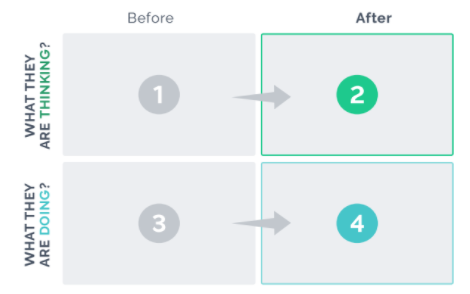Conversational presenting is all about the non-linear, the natural flow of dialogue, and really getting to know your audience. But with all that freedom and flexibility, preparing your content can be a little tricky.
You can’t exactly predict how your next pitch will go (nobody’s a mind reader), but you can certainly make an educated guess at the different directions it could take. Putting in the time to consider your content from a bird’s eye view will help you to identify the primary sections and subsections of your message, as well as the many avenues of interest that will reveal themselves when you let your audience do the driving.
Here are three steps for doing just that.
Step 1: Know your objective
Begin your planning session by considering the perspective of your audience before your presentation. How do you want your audience’s perspective to change? What actions do you want them to take? Plan out these shifts to make sure all content aligns with your goals.

Step 2: Have an actual conversation (or two or three)
Next, call up a friend or colleague, and introduce your idea the way you would in an actual meeting. Let the person on the other line ask questions, and take note of what those questions lead to. Ask for general feedback — both good and bad — and listen carefully for any objections or moments of hesitation.
The goal is to identify which content you need to have in order to achieve the before and after results you outlined in the last step. So, have this same conversation with as many people as possible. Once you have an idea of the variety of reactions your objective will receive, organize them into three columns: questions, objections, and observations. Make sure you have content that addresses each of these items.
Step 3: Mind map it!
A mind map is a great way to visualize all of your content in context. Think of it like a blueprint: mapping out the conversation will give you a complete view of your story, as well as reveal any areas where you might need to add information.
Start by putting your objective at the center of the map. Next, connect this central idea to the top four or so questions from your earlier conversations. These will become your primary topics:

Once you’ve created topics out of your most asked questions, consider the top objections and observations you heard and place them under the relevant topic. This is how you will form your subtopics.
Remember, no amount of information is too much when it comes to conversational presenting. What’s most important in the design phase is to organize your information in a way that reflects the natural flow of conversation.
Developing a solid game plan for the content you present is critical, but it’s not the only thing you need. Download our Presentation Design 101 ebook for an in-depth look at how you can deliver a successful presentation each and every time.